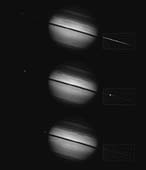|
COMETS EARTH JUPITER KUIPER BELT MARS MERCURY METEORITES NEPTUNE OORT CLOUD PLUTO SATURN SOLAR SYSTEM SPACE SUN URANUS VENUS ORDER PRINTS
PHOTO CATEGORIES SCIENCEVIEWS AMERICAN INDIAN AMPHIBIANS BIRDS BUGS FINE ART FOSSILS THE ISLANDS HISTORICAL PHOTOS MAMMALS OTHER PARKS PLANTS RELIGIOUS REPTILES SCIENCEVIEWS PRINTS
|
Related Document
Download Options
This sequence of images from NASA's Hubble Space Telescope documents a rare astronomical alignment -- Saturn's magnificent ring system turned edge-on. This occurs when the Earth passes through Saturn's ring plane, as it does approximately every 15 years. These pictures were taken with Hubble's Wide Field Planetary Camera 2 on 22 May 1995, when Saturn was at a distance of 919 million miles (1.5 billion kilometers) from Earth. At Saturn, Hubble can see details as small as 450 miles (725 km) across. In each image, the dark band across Saturn is the ring shadow cast by the Sun which is still 2.7 degrees above Saturn's ring plane. The box around the western portion of the rings (to the right of Saturn) in each image indicates the area in which the faint light from the rings has been multiplied through image processing (by a factor of 25) to make the rings more visible. Top This image was taken while the Earth was above the lit face of the rings. The moons Tethys and Dione are visible to the east (left) of Saturn; Janus is the bright spot near the center of the ring portion in the box, and Pandora is faintly visible just inside the left edge of this box. Saturn's atmosphere shows remarkable detail: multiple banding in both the northern and southern hemispheres, wispy structure at the north edge of the equatorial zone, and a bright area above the ring shadow that is caused by sunlight scattered off the rings onto the atmosphere. There is evidence of a faint polar haze over the north pole of Saturn and a fainter haze over the south. Center This image was taken close to the time of ring-plane crossing. The rings are 75% fainter than in the top image, though they do not disappear completely because the vertical face of the rings still reflects sunlight when the rings are edge-on. Rhea is visible to the east of Saturn, Enceladus is the bright satellite in the rings to the west, and Janus is the fainter blip to its right. Pandora is just to the left of Enceladus, but is not visible because Enceladus is too bright. An oval-shaped atmospheric feature has just rotated into view (near the eastern limb, at the northern edge of the equatorial zone), and appears to be a local circulation pattern that is not penetrated by the bright clouds that are deflected around it. Bottom This image was taken approximately 96 minutes (one Hubble orbit) after the center image. The rings are 10% brighter than they were in that image. Rhea is visible just off the eastern limb of Saturn, and casts a shadow on the south face of Saturn. During this exposure, the Earth and Sun were on opposite sides of Saturn's ring plane (they remain in this configuration until 10 August 1995). The atmospheric circulation pattern has rotated to just past the center of the planet's disk, and is followed by more wispy structure in the bright band of clouds, reminiscent of the structure seen during the Saturn storm observed in 1990. These images will be used to determine the time of ring-plane crossing and the thickness of the main rings and to search for as yet undiscovered satellites. Knowledge of the exact time of ring-plane crossing will lead to an improved determination of the rate at which Saturn "wobbles" about its axis (polar precession). Technical Notes - Each of these images is a 7-second exposure at 8922 Angstroms in a methane absorption band. North is up and east is to the left. Credit: Amanda S. Bosh (Lowell Observatory), Andrew S. Rivkin (Univ. of Arizona/LPL), the HST High Speed Photometer Instrument Team (R.C. Bless, PI), and NASA. |
